From Modern and Contemporary Art
20th-century Western art
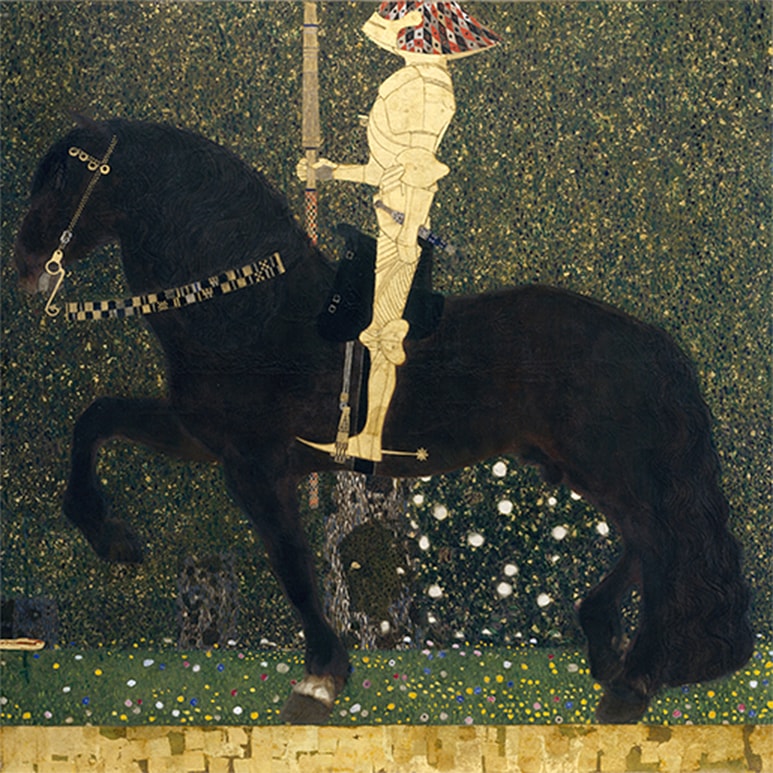
Gustav Klimt,
Life is a Struggle (Golden Rider), 1903
A knight in golden armor pushing on regardless of the evil snake obstructing his way fills most of the square canvas. The Austrian painter Gustav Klimt (1862–1918) began pursuing his own unique art practice after three paintings he was commissioned to produce for the ceiling of the Great Hall of the University of Vienna were criticized as “pornographic.” The appearance of the knight, which references Dürer’s Knight, Death and the Devil (1513), is an allusion to Klimt’s own circumstances at the time. Regarded as one of Klimt’s most important works, Life is a Struggle was once owned by the philosopher Ludwig Wittgenstein’s father, and was the first oil painting by Klimt to enter the collection of a public art museum in Japan.
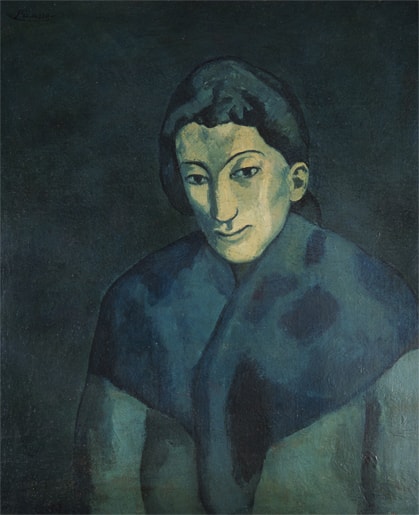
©2025 – Succession Pablo Picasso – BCF (JAPAN)
Pablo Picasso,
Woman in a Blue Shawl, 1902
A woman with a vacant expression wearing a blue shawl sits quietly, the space behind her rendered in deep blue. In 1901, Pablo Picasso (1881–1973), deeply shocked by the suicide of a friend, moved into the friend’s studio and began producing paintings dominated by blue paint and featuring subject matter full of sadness. This period, in which Picasso turned his attention to people alienated from society, such as syphilitic prostitutes in a Paris prison, mothers holding babies, and migrant workers in Barcelona, is called the Blue Period. Dating from this period, Woman in a Blue Shawl was part of Picasso’s personal collection before being inherited by his granddaughter.
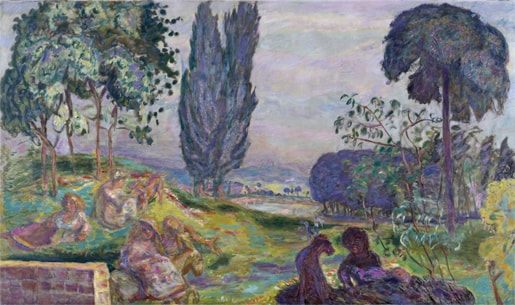
Pierre Bonnard,
Animated Landscape, ca. 1913
This painting depicts a scene on the banks of the river Seine in the Normandy region town of Vernon, where Pierre Bonnard (1867–1947) bought a country house in 1912. On the right, Bonnard’s wife Marthe is relaxing with her pet dog, Ubu, while on the left, other people are also playing with animals. The simple and peaceful rural scene in this large painting conjures images of the idyllic worldview of ancient times. Upon a visit to southern France in 1909, Bonnard was fascinated with the bright light of the region, and came to understand how to work using color. In producing this painting, he was also inspired by the later works of Monet, whose influence can be detected in the heavy use of blue and purple in the areas lit from behind and the areas in shade, as well as in the rapid brushstrokes.
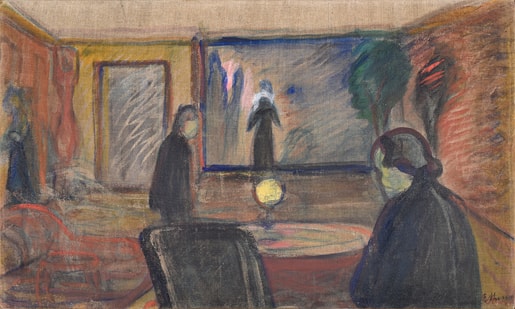
Edvard Munch,
Scene from Ibsen’s Ghosts, 1906
In a room in the home of a widow of a local worthy, several figures whose expressions are invisible stand looking in different directions. Through a large glass window, the remains of an orphanage destroyed by a fire caused by carelessness with a candle can be seen. The almost painful red scattered across the entire canvas and the oppressive dark colors induce a feeling of unrest. The Norwegian painter Edvard Munch (1863–1944) was asked to design the set for a performance of Ghosts, by Norway’s leading playwright Henrik Ibsen, in a small theater in Germany. One of the concept drawings for this set design, this work skillfully conveys the feelings of the characters, who are bound by secrets and anguish.
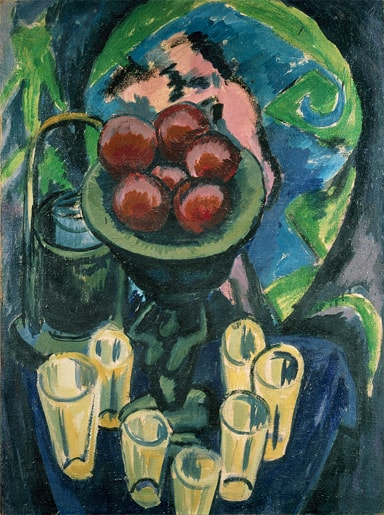
Ernst Ludwig Kirchner,
Still Life with Glasses, 1912
In 1905, Ernst Ludwig Kirchner (1880–1938) formed Die Brücke (The Bridge), one of Germany’s leading Expressionist art groups, with the aim of producing art free from social conventions. In this work, a primitive wooden fruit bowl Kirchner made himself sits on a table together with glasses and a wine cooler, with a wall hanging featuring a naked man and woman depicted in a style reminiscent of African or Oceanian art in the background. One can sense here the contrast between modern and primitive, artificial and natural. The influence of Cézanne and the Cubist artists of the same period can be discerned in the simplified forms and the incorporation of multiple viewpoints, as seen in the dramatically rising table and the wall hanging, which is depicted as if viewed frontally.
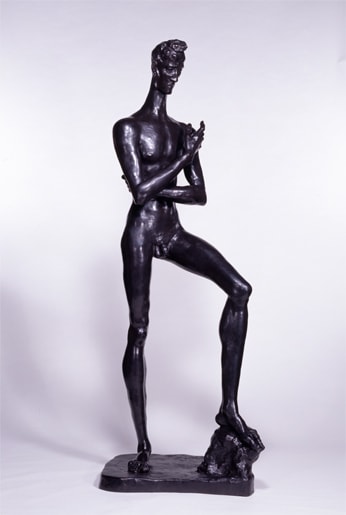
Wilhelm Lehmbruck,
Rising Youth, 1913
Wilhelm Lehmbruck (1881–1919) was inspired by the sculptures of Auguste Rodin during a visit to an exhibition in Düsseldorf in 1904. Later, after moving to Paris in 1910, he was influenced by Aristide Maillol and met a number of avant-garde/abstract artists including Modigliani and Archipenko. He came to associate human body shapes with elongated necks with a strong spiritual makeup and developed into one of the leading sculptors of the Expressionist movement, which emphasized the expression of emotional experience. In this work, the forward position of the left leg creates a large amount of space while the evocative pose with the left arm wrapped around the body and the right arm pointing upwards, the contours of the toned muscles and the highlighting of the joints suggest a strong willingness to fight against adversity.
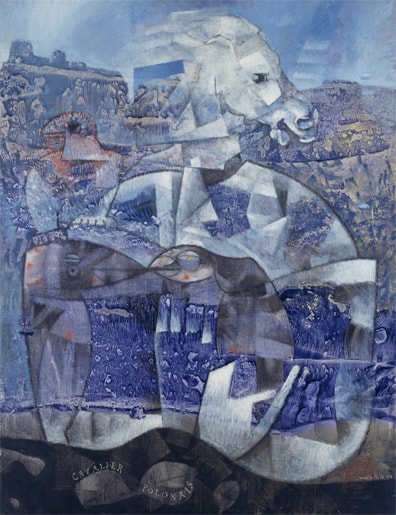
©ADAGP, Paris & JASPAR, Tokyo, 2025 G3854
Max Ernst,
The Polish Rider, 1954
Max Ernst (1891–1976) used various techniques to create haphazard shapes in his picture planes and picked out from them vivid characters. In this work, a white horse embracing two birds with another bird resting on its shoulders stands out against a background with a complex texture produced by placing boards on the paint while it was still wet and then removing them. While modeling his work on Rembrandt’s 1655 painting of the same title of a horseman making his way across a wasteland, Ernst transformed the scene into a completely original one by representing him and his wife in the forms of the two birds, and himself as Loplop, the imaginary bird he regarded as his alter ego.
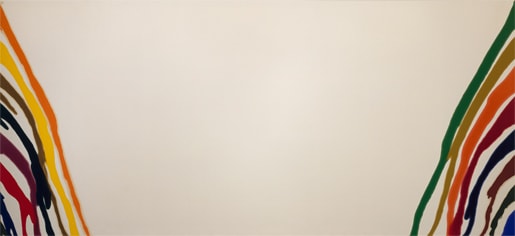
Morris Louis,
Delta Mu, 1960–1961
Acrylic paint in various colors flows from the left and right of an unprimed canvas, forming ribbons like a waterfall, while bare canvas fills most of the center of he picture plane. In 1954, the American painter Morris Louis (1912–1962) thought it would be possible to experience color itself in a pure mode by eliminating such painterly effects as varying thicknesses of paint and brush marks and instead staining large canvases with multiple layers of diluted paint. From then until his death in 1962, Louis experimented repeatedly with various canvas sizes and arrangements of color while changing the direction in which he poured the paint, producing hundreds of works like this one.
Japanese modern art
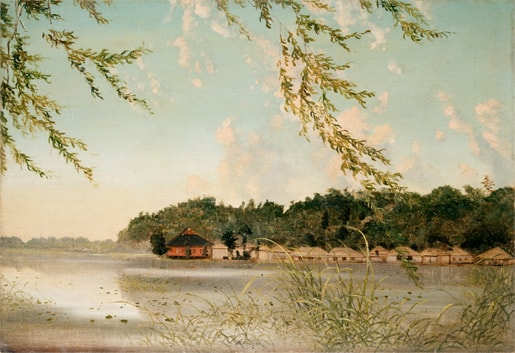
Takahashi Yuichi,
Shinobazu Pond, ca.1880
In this scene, a Benten-do, or Buddhist temple dedicated to the goddess Benten, lit by the setting sun is viewed through the branches of a willow tree from the south bank of Shinobazu Pond in Ueno, a popular place for common people to relax since the olden days. A combination of the perspective-based spatial representation the artist learned from Italian painter Antonio Fontanesi and the composition in which scenery in the distance is viewed through objects in the foreground he learned from Utagawa Hiroshige’s depictions of famous views gives this portrayal of an ideal scene that exists only in the artist’s imagination a sense of reality. In 1872, Takahashi Yuichi (1828–1874) traveled the country studying famous views, and this work is one of the landscapes he produced in his later years based on his sketches from that trip.
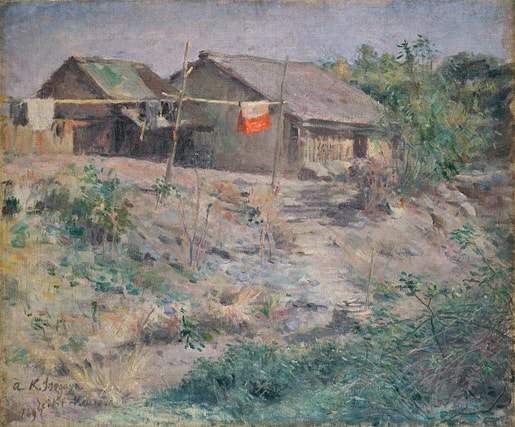
Kuroda Seiki,
Sunny Day, 1897
Kuroda Seiki (1866–1924) traveled to France in the middle of the Meiji period (1868-1912)and brought back to Japan a plein-air-derived style of painting in which the realism of Academic art was tempered with the bright colors of Impressionism. A conflict arose between the old style of yōga, or Western-style painting, based on traditional Western techniques, and the new style practiced by Kuroda and others, but in the late Meiji period the latter became the mainstream of Western-style painting, with Kuroda being appointed director of the newly established Department of Western Painting at the Tokyo Fine Arts School in 1896. This work takes as its subject matter a country scene enveloped by gentle sunlight during the cold season, and while the depiction is unmannered, the red of the washing hanging in the middle of the mainly green and blue picture plane stands out to great effect.
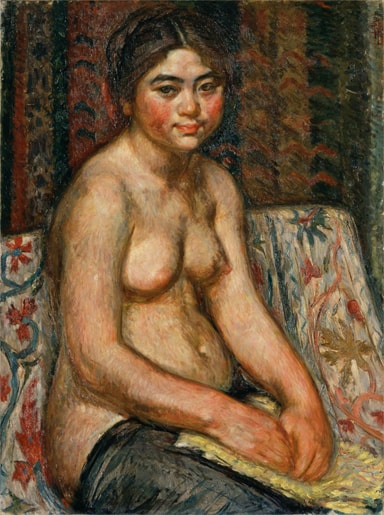
Nakamura Tsune,
Nude Girl, 1914
Afflicted with tuberculosis in 1904 at the age of 17, Nakamura Tsune (1887–1924) joined the Hakubakai (White Horse Society) in 1906, following which he studied Rembrandt, Renoir and Cézanne, and pursued his own unique style while battling his illness. The model for this painting was Soma Toshiko, eldest daughter of the founders of the Nakamura-ya bakery in Shinjuku, Soma Aizo and Kokko. Nakamura, who had been living at the atelier behind Nakamura-ya since late 1911, used Toshiko as his model frequently from around 1913, when she was a student at Joshi Seigakuin school for girls. The influence of Renoir can be seen in the depiction of Toshiko’s young, healthy body, but her expression, with lips closed and intelligent gaze directed at the artist, and the vibrant red color of her cheeks are characteristic of Nakamura’s own style.
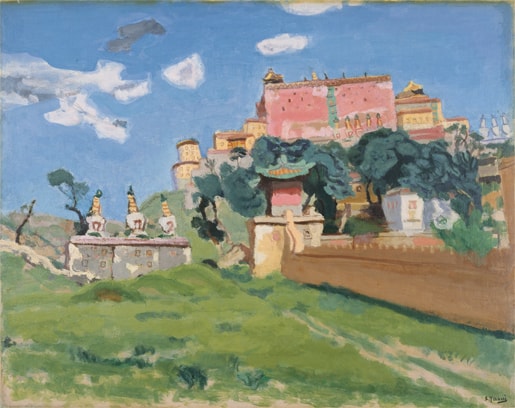
Yasui Sotaro,
Lamaist Shrine at Chengteh, 1938
Chengteh is a city in Hebei province in the northeastern part of China that is famous for having been used as a summer resort by successive emperors. In this painting, a Tibetan Buddhist temple on top of a hill lit by sunlight and shining brightly under a clear blue sky is depicted in a carefree manner with broad brushstrokes. Yasui Sotaro (1888–1955), who was invited to Hsinking (present-day Changchun) to serve as a judge at an art exhibition in 1937, stopped in Chengteh on his way back to Japan and sketched the local scenery. The bold, deformed shapes and bright colors give a vivid sensibility to the picture plane in this work from Yasui’s mature period.
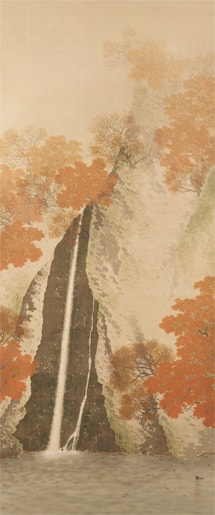
Hishida Shunso,
Landscape in Autumn, 1908
From around 1899, Hishida Shunso (1874–1911) along with Yokoyama Taikan and others began experimenting with a new method of Japanese-style painting that eschewed lines in favor of a gradation of colors. Called mōrō-tai (vague or hazy style), this method was developed to express the diffusion of light and the humidity in the atmosphere but was unsuited to the depiction of the solidity and texture of objects. In order to make up for this weakness, Hishida gradually introduced a pointillist dot technique, this work being a representative example of this experimentation. The choppy water surface at the bottom of the waterfall is portrayed using mōrō-tai color gradation. At the same time, the artist has cleverly tried to represent the surface of the rock face over which the waterfall flows using a combination of fine brushstrokes and different concentrations of black ink.
Japanese contemporary art
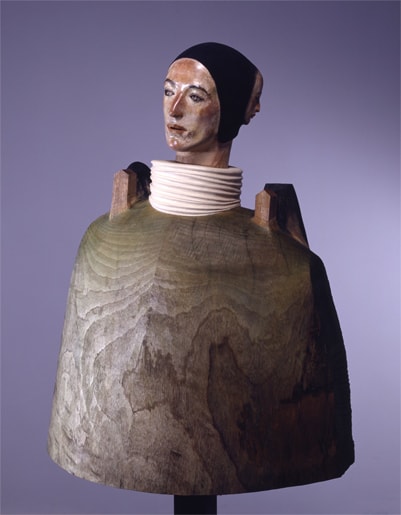
©舟越 桂
Funakoshi Katsura,
The Moon Sleeps on the Shoulder, 1996
This bust has a small face on the back of its head in addition to a regular face, and a house and a mountain on each shoulder. Since 1979, Funakoshi Katsura (b. 1951) has been creating painted camphor wood statues with marble eyes inserted using a technique traditionally employed in the making of wooden Buddhist statues. At first he produced mainly half-length statues of contemporary individuals using actual people as models that wore calm expressions and appeared to be staring into the distance. From around 1995, however, there was a change in the appearance of his works into strange-looking humanoids with horns or animal-like ears. This work, in which the body itself assumes the proportions of a mountain, is an early example of this new direction and earned Funakoshi the Hirakushi Denchu Sculpture Prize in 1997.

Nara Yoshitomo,
Girl From the North Country, 2014
Tightly closed lips. Bangs trimmed in a straight line. Eyes looking straight ahead. The children depicted by Nara Yoshitomo (b. 1959) seem to be filled with all manner of feelings, including a sense of security and of unease, of intimacy and loneliness. His works are adored by people all around the world regardless of their specialist knowledge of art. The title of this work is thought to be a reference to the 1963 song by Bob Dylan. Music is undoubtedly one of the sources of Nara’s expression. One also senses in this depiction of a “girl from the north country” Nara’s feelings as a native of Aomori Prefecture for the Tohoku region.
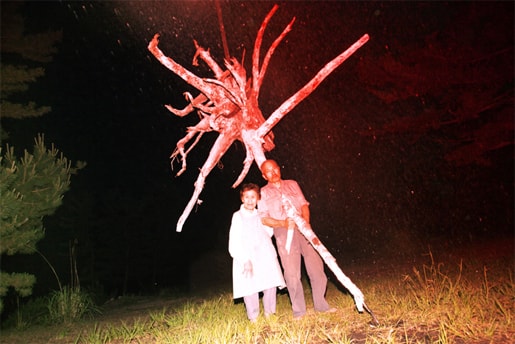
Shiga Lieko,
Portrait of cultivation, from the series “Rasen Kaigan,” 2009
This is a photographic portrait of an elderly couple, but the first thing that catches the eyes is the large tree piercing the man’s chest. Moreover, the end of the tree is stuck in the ground, as if both the man and the tree are rooted in the earth. A native of Aichi Prefecture, Shiga Lieko (b. 1980) moved to a coastal area in Miyagi Prefecture in 2008, and has since been closely involved with the people of the area. In 2012 she completed her “Rasen Kaigan” series, of which this work, inspired by an episode from the region’s history in which people cleared the land for cultivation by pulling out pine trees by hand, is a representative example. According to Shiga, to take the photograph she actually dug up the roots of a pine tree herself and inserted the man between two parts. The artist’s experience and the history and traditions of the region come together and are expressed in a mystical form.
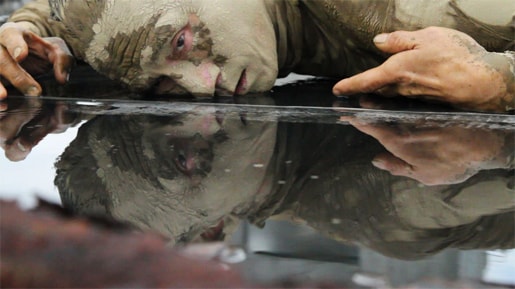
©CHIKAKO YAMASHIRO
Yamashiro Chikako,
Beginning of Creation, Abduction / A Child, 2015 (AAC/APMoA Film)
Dancer Kawaguchi Takao studied a video recording of a legendary performance by the late Ohno Kazuo, a famous exponent of the dance form known as Butoh, and attempted to copy his movements. At a glance, this video work by Yamashiro Chikako (b. 1976) in which she filmed Kawaguchi as he tried to faithfully reproduce the movements of someone else, appears to be an objective record. However, as it becomes less and less clear whom the body on screen actually belongs to, the work gradually evokes a strange feeling. One can see parallels to this in Yamashiro’s own interests as an artist who was born in Okinawa and has dealt with the theme of how to pass on memories of the Battle of Okinawa despite having no actual experience of it.
From the Kimura Teizo Collection